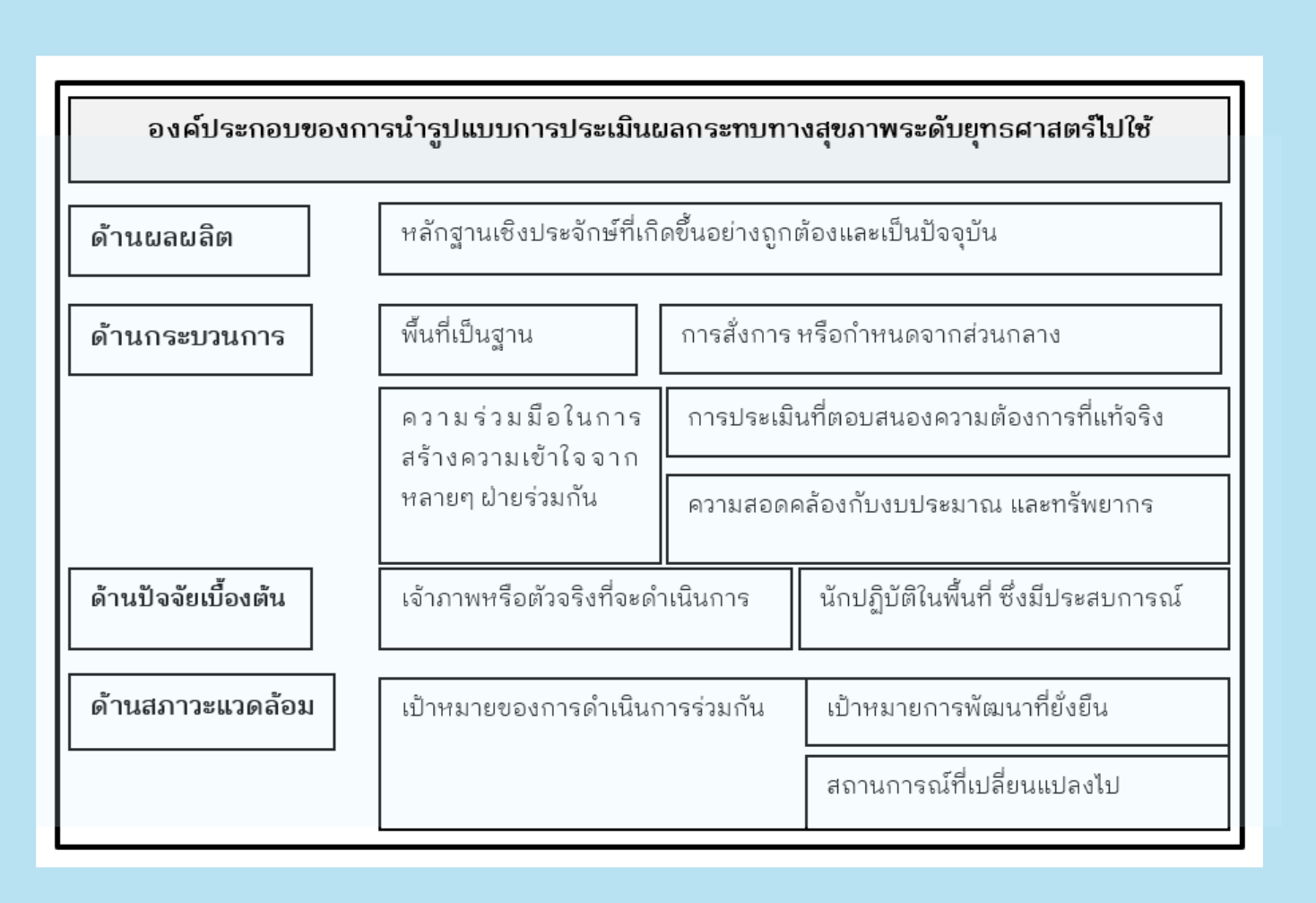ความเป็นไปได้ของการนำรูปแบบการประเมินผลกระทบทางสุขภาพระดับยุทธศาสตร์ไปใช้: กรณีศึกษาการท่องเที่ยวโดยชุมชน เขตพัฒนาการท่องเที่ยวอันดามัน
คำสำคัญ:
ความเป็นไปได้, รูปแบบ, การประเมินผลกระทบทางสุขภาพ, การท่องเที่ยวโดยชุมชนบทคัดย่อ
การศึกษานี้มีวัตถุประสงค์เพื่อศึกษาความเป็นไปได้ของการนำรูปแบบการประเมินผลกระทบทางสุขภาพระดับยุทธศาสตร์ไปใช้ กรณีศึกษาการท่องเที่ยวโดยชุมชน เขตพัฒนาการท่องเที่ยวอันดามัน เป็นการวิจัยเชิงคุณภาพในรูปพหุกรณีศึกษา 2 ขั้นตอนหลัก คือ 1) ดำเนินการโดยใช้วิธีการสนทนากลุ่ม/ออนไลน์ ในประชาชนที่อาศัยอยู่ในชุมชน และผู้ประกอบการท่องเที่ยวโดยชุมชน ในชุมชนบ้านสามช่องเหนือ บ้านหัวควน บ้านนาตีน บ่อหินฟาร์มสเตย์ และบ้านบ่อเจ็ดลูก จำนวน 10 คน และ 2) ดำเนินการโดยใช้วิธีการประชุมกลุ่ม/ออนไลน์ในคณะกรรมการพัฒนาการท่องเที่ยว เขตพัฒนาการท่องเที่ยวอันดามัน จำนวน 20 คน วิเคราะห์ข้อมูลใช้วิธีการวิเคราะห์เชิงเนื้อหา และเชิงบรรยาย ผลการศึกษาพบว่า ความเป็นไปได้ในการนำไปใช้ประกอบด้วย 4 องค์ประกอบ ดังนี้ 1) ด้านสภาวะแวดล้อมคือ การนำไปใช้ต้องตอบสนองต่อเป้าหมายของการดำเนินการร่วมกัน ทั้งเป้าหมายการพัฒนาที่ยั่งยืน และสถานการณ์ที่เปลี่ยนแปลงไป 2) ด้านปัจจัยเบื้องต้น ประกอบด้วย 1. ผู้รับผิดชอบตามหน้าที่ที่ดำเนินการ และ 2. นักปฏิบัติการในพื้นที่ที่มีประสบการณ์ 3) ด้านกระบวนการ จำเป็นต้องใช้ 1. พื้นที่เป็นฐาน 2. ความร่วมมือในการสร้างความเข้าใจจากหลายๆ ฝ่ายร่วมกัน 3. การออกแบบการประเมินที่ตอบสนองความต้องการที่แท้จริง 4. การสั่งการ หรือกำหนดจากส่วนกลาง และ 5. ความสอดคล้องกับงบประมาณและทรัพยากรที่มี และ 4) ด้านผลผลิต จะต้องสอดคล้องกับหลักฐานเชิงประจักษ์ที่เกิดขึ้นอย่างถูกต้องและเป็นปัจจุบัน
เอกสารอ้างอิง
Bennett, N. J., Kadfak, A., & Dearden, P. (2016). Community-based scenario planning: A process for vulnerability analysis and adaptation planning to social–ecological change in coastal communities. Environment, Development and Sustainability, 18(6), 1771–1799.
Bice, S., & Fischer, T. B. (2020). Impact assessment for the 21st century – what future? Impact Assessment and Project Appraisal, 38(2), 89–93.
Bowers, J. (2016). Developing sustainable tourism through ecomuseology: A case study in the Rupununi region of Guyana. Journal of Sustainable Tourism, 24(5), 758–782.
Dahlgren, G., & Whitehead, M. (2007). Policies and strategies to promote social equity in health. Institute for Futures Studies.
Eikemo, T. A., Bambra, C., Huijts, T., & Fitzgerald, R. (2017). The First Pan-European Sociological Health Inequalities Survey of the General Population: The European Social Survey Rotating Module on the Social Determinants of Health. European Sociological Review, 33(1), 137–153.
Harris-Roxas, B., Viliani, F., Bond, A., Cave, B., Divall, M., Furu, P., et al., (2012). Health impact assessment: The state of the art. Impact Assessment and Project Appraisal, 30(1), 43–52.
Higgins-Desbiolles, F. (2020). Socialising tourism for social and ecological justice after COVID-19. Tourism Geographies, 22(3), 610–623.
The Institute of Public Health in Ireland. (2003). Health Impact Assessment—A practical guidance manual. Retrieved April 19, 2020, from https://publichealth.ie/reports/health-impact-assessment-practical-guidance-manual-2003
Kanchanachitra, C., Pothisita, C., Archavanijkul, K., Jamchan, C., Siriratmongkol, K., Thipsuk, P. et al., (2011). Health. Thai people 2011: HIA Mechanism for Public Policy Development for Life and Health. Institute for Population and Social Research. Mahidol University (in Thai)
Koodsela, W., Dong, H., & Sukpatch, K. (2019). A Holistic Conceptual Framework into
Practice-Based on Urban Tourism Toward Sustainable Development in Thailand. Sustainability, 11(24), 7152. https://doi.org/10.3390/su11247152
Khunnikom, P. (2023). Model Development of Strategic Health Impact Assessment on
the Community-Based Tourism: A Case Study of Andaman Tourism Development Areas. A Dissertation Submitted in Partial Fulfillment of the Requirements for the Degree of Doctoral of Philosophy, Prince of Songkla University.
Khunnikom, P., Muneenam, U., & Sukmag, P. (2022). Community based-tourism (CBT)
management during the coronavirus pandemic along the Andaman coast of Thailand. GeoJournal of Tourismand Geosites, 44(4), 1435–1441. https://doi.org/10.30892/gtg.44431-963
Lee, T. H., & Jan, F.-H. (2019). Can community-based tourism contribute to sustainable development? Evidence from residents’ perceptions of the sustainability. Tourism Management, 70, 368–380.
Linzalone, N., Ballarini, A., Piccinelli, C., Viliani, F., & Bianchi, F. (2018). Institutionalizing Health Impact Assessment: A consultation with experts on the barriers and facilitators to implementing HIA in Italy. Journal of Environmental Management, 218, 95–102.
Linzalone, N., Assennato, G., Ballarini, A., Cadum, E., Cirillo, M., Cori, L., et al., (2014). Health Impact Assessment practice and potential for integration within Environmental Impact and Strategic Environmental Assessments in Italy. International Journal of Environmental Research and Public Health, 11(12), 12683–12699.
Mayers, J. (2005). Getting started. Power tools series. International Institute for Environment and Development, London, UK.
National health Commission Office. (2017). Guidelines and methods for health
Impact assessment arising from public policy (2nd ed.). Bangkok: Supaprinting.(In Thai)
Schneider, L. N. (2020). Strategic management as adaptation to changes in the ecosystems of public hospitals in Israel. Israel Journal of Health Policy Research, 9(1), 65.
Sharafuddin, M. A. (2015). Types of Tourism in Thailand. e-Review of Tourism Research (eRTR),3(12), 210-219.
Shi, Q., & Liu, T. (2020). Should internal migrants be held accountable for spreading COVID-19? Environment and Planning A: Economy and Space, 0308518X20916764. https://doi.org/10.1177/0308518X20916764
Sohn, E. K., Stein, L. J., Wolpoff, A., Lindberg, R., Baum, A., McInnis-Simoncelli, A., & Pollack, K. M. (2018). Avenues of Influence: The Relationship between Health Impact Assessment and Determinants of Health and Health Equity. Journal of Urban Health, 95(5), 754–764.
Stufflebeam, D.L. (1971). Education Evaluation and Decision Making.Illinois: Peacock
Publisher Inc.
The Office of Strategy Management, Southwest Andaman. (2016). OSM Andaman Development Plan (Ranong, Phang Nga, Phuket, Krabi,Trang) 2018-2021. Retrieved April 19, 2020, from http://www.osmsouth-w.moi.go.th/submenu.php?page=162&l (in Thai)
Thondoo, M., Rojas-Rueda, D., Gupta, J., de Vries, D. H., & Nieuwenhuijsen, M. J. (2019). Systematic Literature Review of Health Impact Assessments in Low and Middle-Income Countries. International Journal of Environmental Research and Public Health, 16(11), 2018.
Weatherdon, L. V., Magnan, A. K., Rogers, A. D., Sumaila, U. R., & Cheung, W. W. L. (2016). Observed and Projected Impacts of Climate Change on Marine Fisheries, Aquaculture, Coastal Tourism, and Human Health: An Update. Frontiers in Marine Science, 3. doi.org/10.3389/fmars.2016.00048

ดาวน์โหลด
เผยแพร่แล้ว
รูปแบบการอ้างอิง
ฉบับ
ประเภทบทความ
สัญญาอนุญาต
ลิขสิทธิ์ (c) 2023 วารสารสาธารณสุขและวิทยาศาสตร์สุขภาพ

อนุญาตภายใต้เงื่อนไข Creative Commons Attribution-NonCommercial-NoDerivatives 4.0 International License.
บทความทุกบทความที่ได้รับการตีพิมพ์ถือเป็นลิขสิทธิ์ของ วารสารสาธารณสุข















